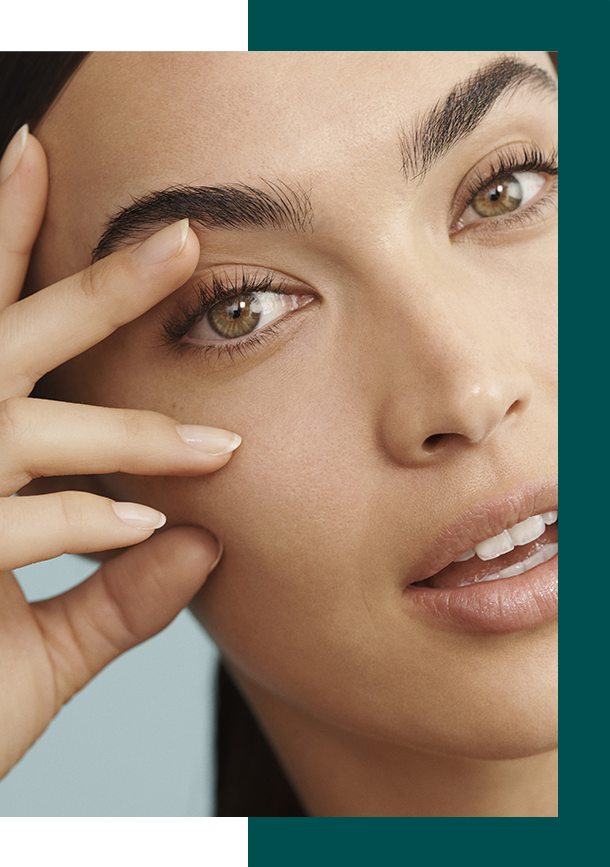Grow your lashes
LATISSE® is the first prescription product to treat inadequate lashes—it’s believed to prolong the active eyelash growth phase. It’s clinically proven to deliver lashes that are fuller, longer, and darker at 16 weeks.
HOW TO USE
LATISSE® solution should always be placed on the provided applicator and applied carefully across the skin of the upper eyelid margin at the base of the eyelashes. LATISSE® solution should never be applied to the lower lid, in the eye, or as an eye drop. After 16 weeks, talk with your doctor about ongoing use.
1.Once nightly, make sure your face is clean and makeup and contact lenses are removed.
2.Remove a sterile applicator from the tray. Then, while holding the applicator horizontally, place one drop of LATISSE® on the area of the applicator closest to the tip but not on the tip.
3.Immediately brush the applicator carefully along the skin at the base of the upper eyelashes (where the eyelashes meet your skin), going from the inner part of your lash line to the outer part.
4.Use a tissue to blot any excess solution that goes beyond the eyelid.
5.Throw away the applicator. Each applicator should be used once.
6.Repeat the steps for the opposite eyelid with a new, sterile applicator.
- Apply LATISSE® daily for 16 weeks. Do not reduce or stop application when you first notice results
- If you miss a dose, don’t try to play “catch-up.” Just apply LATISSE® the next day
- Using LATISSE® more than once a day will not increase eyelash growth
- DO NOT APPLY directly into the eye or to the lower lid, and blot excess solution with a tissue
- It is possible for hair growth to occur in other areas of your skin that LATISSE® frequently touches
- Only use the sterile applicators supplied with the LATISSE® kit to apply the product
- Don’t allow the tip of the bottle or applicator to touch your fingers or any other unintended surface, as contamination by common bacteria is known to cause infections
- Remove contact lenses prior to applying LATISSE® solution. Contact lenses may be reinserted 15 minutes after application
- If you get LATISSE® in your eye, do not rinse your eye. It is not expected to cause harm
- It is possible for a difference in eyelash length, thickness, fullness, pigmentation, number of eyelash hairs, and/or direction of eyelash growth to occur between eyes
- Remember, if you stop using LATISSE®, lashes will gradually return to their previous appearance



Join Allē today for savings on future treatments
Join AllēEXPAND +
LATISSE® (bimatoprost ophthalmic solution) 0.03% Important Information
Approved UseLATISSE® is an FDA-approved treatment to grow eyelashes for people with inadequate or not enough lashes.
Important Safety InformationDo not use LATISSE® if you are allergic to one of its ingredients. If you use/used prescription products for eye pressure problems, use LATISSE® under doctor care.
LATISSE® (bimatoprost ophthalmic solution) 0.03% Important Information
Approved UseLATISSE® is an FDA-approved treatment to grow eyelashes for people with inadequate or not enough lashes.
Important Safety InformationDo not use LATISSE® if you are allergic to one of its ingredients. If you use/used prescription products for eye pressure problems, use LATISSE® under doctor care. May cause brown darkening of the colored part of the eye which is likely permanent. LATISSE® may cause eyelid skin darkening which may be reversible. Only apply at base of upper lashes. DO NOT APPLY to lower lid. Hair may grow outside the treatment area. If you have eye problems/surgery, consult your doctor. Common side effects include itchy and red eyes. If discontinued, lashes gradually return to previous appearance.
These are not all the possible side effects of LATISSE®. For more information, please talk to your doctor.
Please see LATISSE® full Product Information.